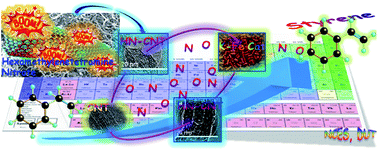Increased active sites and their accessibility of a N-doped carbon nanotube carbocatalyst with remarkably enhanced catalytic performance in direct dehydrogenation of ethylbenzene†
Abstract
This work presents an efficient and low-cost one-step strategy for simultaneously N-doping and increasing surface ketonic C![[double bond, length as m-dash]](https://www.rsc.org/images/entities/char_e001.gif) O groups and structural defects of a N-doped carbon nanotube (HN-CNT) through the explosive decomposition of hexamethylenetetramine (HTA) nitrate, a low-cost N,O-containing organic compound. The as-synthesized HN-CNT demonstrates a 1.64 and 2.19 times higher steady-state styrene rate with 98.5% selectivity towards styrene for direct dehydrogenation (DDH) than that of the parent CNT and H-CNT prepared by the similar pyrolysis procedure to that for the HN-CNT except for replacing HTA nitrate with HTA.
O groups and structural defects of a N-doped carbon nanotube (HN-CNT) through the explosive decomposition of hexamethylenetetramine (HTA) nitrate, a low-cost N,O-containing organic compound. The as-synthesized HN-CNT demonstrates a 1.64 and 2.19 times higher steady-state styrene rate with 98.5% selectivity towards styrene for direct dehydrogenation (DDH) than that of the parent CNT and H-CNT prepared by the similar pyrolysis procedure to that for the HN-CNT except for replacing HTA nitrate with HTA.


 Please wait while we load your content...
Please wait while we load your content...